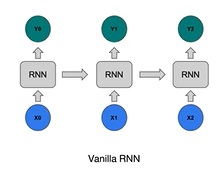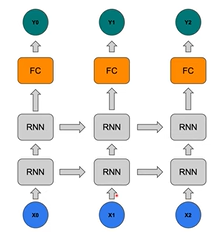[모두를 위한 딥러닝 시즌2] Lab-11-3 RNN Long sequence
[모두를 위한 딥러닝 시즌2] Lab-11-3 RNN Long sequence
Longseq introduction
- 기존의 RNN 모델들은 짧은 문장을 하나의 샘플로 사용
- 실용적인 모델은 긴 문장 데이터셋을 사용해야 함
하지만 긴 문장을 하나의 입력으로 처리하는 것은 어려움
→ 특정 사이즈의 청크로 나눠 학습해야 한다
Making sequence dataset from long sentence
과정
- 윈도우 기반 슬라이딩 기법을 사용해 sentence를 나누어 Dataset 생성
- X 데이터는 입력 시퀀스, Y 데이터는 다음 시퀀스를 예측하기 위한 타겟으로 구성
code
- 윈도우 설정
- 문장을
sequence_length크기의 윈도우로 자른다
- 문장을
- 데이터 구성
- X는 현재 청크, Y는 오른쪽으로 한 글자 이동한 청크로 설정
- 데이터 변환
- 청크 데이터를 one-hot vector로 변환하고 PyTorch 텐서로 변환
1
2
3
4
5
6
7
8
9
10
11
12
13
14
15
16
17
18
19
20
21
22
23
24
25
26
27
28
29
30
# data setting
x_data = []
y_data = []
for i in range(0, len(sentence) - sequence_length):
x_str = sentence[i:i + sequence_length]
y_str = sentence[i + 1: i + sequence_length + 1]
print(i, x_str, '->', y_str)
x_data.append([char_dic[c] for c in x_str]) # x str to index
y_data.append([char_dic[c] for c in y_str]) # y str to index
x_one_hot = [np.eye(dic_size)[x] for x in x_data]
# transform as torch tensor variable
X = torch.FloatTensor(x_one_hot)
Y = torch.LongTensor(y_data)
# 0 if you wan -> f you want
# 1 f you want -> you want
# 2 you want -> you want t
# 3 you want t -> ou want to
# 4 ou want to -> u want to
# 5 u want to -> want to b
# 6 want to b -> want to bu
# 7 want to bu -> ant to bui
# ...
# 166 ty of the -> y of the s
# 167 y of the s -> of the se
# 168 of the se -> of the sea
# 169 of the sea -> f the sea.
최근에는 10기가 바이트 정도의 큰 텍스트 데이터셋으로도 모델을 학습한다
(예: Wikipedia Dump, OpenWebText)
Adding FC layer and stacking RNN
- 1-Layer RNN
- 단일 RNN 레이어는 복잡한 문장을 학습하기엔 한계가 있다 (언더피팅)
- Stacked RNN + Fully Connected Layer
- RNN 레이어를 쌓고(Stacking) 마지막에 Fully Connected Layer를 추가
code
1
2
3
4
5
6
7
8
9
10
11
12
13
# declare RNN + FC
class Net(torch.nn.Module):
def __init__(self, input_dim, hidden_dim, layers):
super(Net, self).__init__()
self.rnn = torch.nn.RNN(input_dim, hidden_dim, num_layers=layers, batch_first=True)
self.fc = torch.nn.Linear(hidden_dim, hidden_dim, bias=True)
def forward(self, x):
x, _status = self.rnn(x)
x = self.fc(x)
return x
net = Net(dic_size, hidden_size, 2)
Code run through
결과 해석
- Max 기법
- 모델 출력에서 확률이 가장 높은 값을 선택하여 다음 문자 시퀀스를 생성 (argmax)
- 결과 확인
- 모델의 출력 시퀀스가 원본 문장과 얼마나 유사한지를 확인
1
2
3
4
5
6
7
8
9
10
11
12
13
14
15
16
17
18
19
20
21
22
23
24
25
26
27
28
29
30
31
32
33
34
35
36
37
38
39
40
41
42
43
44
45
46
47
48
49
50
51
52
53
54
55
56
57
58
59
60
61
62
63
64
65
66
67
68
69
70
71
72
73
74
75
76
77
78
79
80
81
82
83
84
85
86
87
88
89
90
91
92
93
94
95
96
97
98
99
100
101
102
103
104
105
106
107
108
109
110
111
112
113
114
115
116
117
118
119
120
121
122
123
124
125
import torch
import torch.optim as optim
import numpy as np
# 랜덤 시드 설정 (결과 재현성을 위해)
torch.manual_seed(0)
# 학습할 문장 데이터
sentence = ("if you want to build a ship, don't drum up people together to "
"collect wood and don't assign them tasks and work, but rather "
"teach them to long for the endless immensity of the sea.")
# 문자 집합 생성 (문자 중복 제거)
char_set = list(set(sentence))
# 문자와 인덱스를 매핑
char_dic = {c: i for i, c in enumerate(char_set)}
# 하이퍼파라미터 설정
dic_size = len(char_dic) # 문자 집합의 크기 (사전 크기)
hidden_size = len(char_dic) # RNN의 히든 크기
sequence_length = 10 # 시퀀스 길이
learning_rate = 0.1 # 학습률
# 입력(X)과 출력(Y) 데이터 생성
x_data = []
y_data = []
for i in range(0, len(sentence) - sequence_length):
# 현재 시퀀스 청크 (X)와 다음 시퀀스 청크 (Y)를 설정
x_str = sentence[i:i + sequence_length]
y_str = sentence[i + 1:i + sequence_length + 1]
print(i, x_str, '->', y_str)
# 문자를 인덱스로 변환하여 저장
x_data.append([char_dic[c] for c in x_str])
y_data.append([char_dic[c] for c in y_str])
# 원-핫 인코딩
x_one_hot = [np.eye(dic_size)[x] for x in x_data]
# 0 if you wan -> f you want
# 1 f you want -> you want
# 2 you want -> you want t
# 3 you want t -> ou want to
# 4 ou want to -> u want to
# ...
# 166 ty of the -> y of the s
# 167 y of the s -> of the se
# 168 of the se -> of the sea
# 169 of the sea -> f the sea.
# 텐서로 변환
X = torch.FloatTensor(x_one_hot) # 입력 데이터
Y = torch.LongTensor(y_data) # 출력 데이터
# RNN + Fully Connected Layer 모델 정의
class Net(torch.nn.Module):
def __init__(self, input_dim, hidden_dim, layers):
super(Net, self).__init__()
# RNN 정의
self.rnn = torch.nn.RNN(input_dim, hidden_dim, num_layers=layers, batch_first=True)
# Fully Connected Layer 정의
self.fc = torch.nn.Linear(hidden_dim, hidden_dim, bias=True)
def forward(self, x):
# RNN을 통과
x, _status = self.rnn(x)
# Fully Connected Layer를 통과하여 최종 출력 생성
x = self.fc(x)
return x
# 모델 초기화
net = Net(dic_size, hidden_size, 2) # 2개의 RNN 레이어 사용
# 손실 함수와 옵티마이저 설정
criterion = torch.nn.CrossEntropyLoss() # 크로스 엔트로피 손실 함수
optimizer = optim.Adam(net.parameters(), learning_rate) # Adam 옵티마이저
# 모델 학습
for i in range(100): # 100 에포크
optimizer.zero_grad() # 기울기 초기화
outputs = net(X) # 모델 예측
loss = criterion(outputs.view(-1, dic_size), Y.view(-1)) # 손실 계산
loss.backward() # 역전파
optimizer.step() # 가중치 업데이트
# 예측 결과 처리
results = outputs.argmax(dim=2) # argmax를 사용해 가장 높은 확률의 문자 선택
predict_str = ""
for j, result in enumerate(results):
if j == 0:
# 첫 번째 시퀀스는 전체를 추가
predict_str += ''.join([char_set[t] for t in result])
else:
# 이후 시퀀스는 마지막 문자만 추가
predict_str += char_set[result[-1]]
# 예측된 문자열 출력
print(predict_str)
# b'''bp'cp'''fp'ppb'cpp'cc''c'cpp'''cppb'bpcpcbpcpcfpcccpc'''p''pp'pp''cppc'p'c'cpp'''pccp''''pcccfpc'c'p'c'cf''c'pcb''p'cc'''pc'c'fpcccfp'cbpc'pp'''pc'p'ccpcc'p'cppcf''cpp'ppc'cpp
# nnntonnnttttotdoootttotototttottttttttootttottttotottoottttoodtttttttttootdttototttttttoooddtootdootsttodttoottttttotottootdoottttottttoodtttotttttotttototttttottttootttttootttooo
# t t t t t t t t t t t t t t t t t d t t t t t t t t t t t t t t t t t d t t t t
# t ottotot t totot t t tootottottot ot ttot ttot ttot ott ttottottot otot t tottottot tot ot ttott tot otoototot tt tot oto tottot tott t tootot tototttott t ttot ttot t t
# io t totot tototototo ototo oto to tot ot t to tototot to oto toto t toto t tototo tot t toto tot t totototototototototo tot toto
# e ' e t t e e e e e t e e e
# d d d d d d d d d e e d d d d d ee d d d d d d d d d d d d d e d d e d d d d d d d d d d e d d d d d d e d d e e d d d
# d d e d t e t t p d d d t d p r e t t d e to t d t e d t e t t e re d t t d t e ep t d t p d d d t e p r e e t t d eee
# t ts t to t t e t t re t t to t t p re t t t t t to t t t t t t t tt t ps t t to t t t t ep t t p t to t t t p t e t e t t t
# ttot t etotott t tototoe eotot totot totoeotte tot t e ttott eortoto t tototttototo t eo totoeotototo ttototototoeo tot t toeo totto totot toeototot t to tt t tottoe tot
# ...
# sthrcth t to t i t tmt ems do 't d gt tpeaeo le thnnt er to do ae t to l t d ton't dmsi nstoem toste t d to lt t a a t er torchethem to to d t d theme d e toep eesert d toemsint
# thncth t to t i t dmteeps don't a gk tpepeo le thnnt em to do ae t do l dmd don't atsinnstoem aosts a d do ls t a d ther tonchethem to do d thg theme d e siep eesero a toemsint
# th cth t to t i t dmt eis don't a gk apepeo le thnnt em to 'o le t to l drd don't atsin stoem tosks r d do ks t a r them tonshethem to do d thn thems d ensoip eesii a toems it
# th cto t to t i t d t eis ton't a t rpspeo le thnnt em to 'o ae t to d dnd don't atsinnstoem tosks r d do ks t t r them tonch them to to d thn thems d ensoim esiit a thems nt
# to lto d to d i t d t eps don't a ut rpspeo le thnnt em to 'o ae t do d d d don't a sign toem tosks i d do ks t t r them tonco them to do d ton theme d ersoim nsirt a toemeonn
# m thncto t to tui t d shers don't arut rpspeo le thnet em to do ae t do d d d don't a sign toem tosks i d do ks t t r them torco them to do d thn theme duersoim eesitt ar toemeo t
# m ehncto t tontui t d theps ton't arut dpskeonle thnet er th co le t do d t d don't assign them tosks a d do k, t t r ther thrc them to 'o d t n theme due , im etsitt ar themehnt
# ...
# m tou want to build a ship, don't drum up people together to collect wood and don't assign them tosks and work, but rather teach them to long for the endless immensity of the sea
# m tou want to build a ship, don't drum up people together to collect wood and don't assign them tosks and work, but rather teach them to long for the endless immensity of the seas
# l tou want to build a ship, don't drum up people together to collect wood and don't assign them tasks and work, but rather teach them to long for the endless immensity of the seas
# l tou want to build a ship, don't drum up people together to collect wood and don't assign them tasks and work, but rather teach them to long for the endless immensity of the seas
# l tou want to build a ship, don't drum up people together to collect wood and don't assign them tosks and work, but rather teach them to long for the endless immensity of the sea.
# m tou want to build a ship, don't drum up people together to collect wood and don't assign them tosks and work, but rather teach them to long for the endless immensity of the sea.
This post is licensed under CC BY 4.0 by the author.


